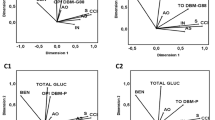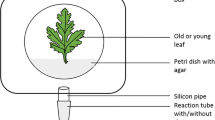Abstract
The ecological implications on biological control of insecticidal transgenic plants, which produce crystal (Cry) proteins from the soil bacterium Bacillus thuringiensis (Bt), remain a contentious issue and affect risk assessment decisions. In this study, we used a unique system of resistant insects, Bt plants and a parasitoid to critically evaluate this issue. The effects of broccoli type (normal or expressing Cry1Ac protein) and insect genotype (susceptible or Cry1Ac-resistant) of Plutella xylostella L. (Lepidoptera: Plutellidae) were examined for their effects on the development and host foraging behavior of the parasitoid, Diadegma insulare (Cresson) (Hymenoptera: Ichneumonidae) over two generations. Parasitism rate and development of D. insulare were not significantly different when different genotypes (Bt-resistant or susceptible) of insect host larvae fed on non-Bt broccoli plants. D. insulare could not discriminate between resistant and susceptible genotypes of P. xylostella, nor between Bt and normal broccoli plants with different genotypes of P. xylostella feeding on them. No D. insulare could emerge from Bt broccoli-fed susceptible and heterozygous P. xylostella larvae because these larvae were unable to survive on Bt broccoli. The parasitism rate, developmental period, pupal and adult weights of D. insulare that had developed on Bt broccoli-fed Cry1Ac-resistant P. xylostella larvae were not significantly different from those that developed on non-Bt broccoli-fed larvae. Female D. insulare emerged from Cry1Ac-resistant P. xylostella that fed on Bt plants could successfully parasitize P. xylostella larvae. The life parameters of the subsequent generation of D. insulare from P. xylostella reared on Bt broccoli were not significantly different from those from non-Bt broccoli. The Cry1Ac protein was detected in P. xylostella and in D. insulare when hosts fed on Bt broccoli. These results are the first to indicate that Cry1Ac did not harm the development or host acceptance of an important endoparasitoid after two generations of exposure. We suggest that using other Bt crops and resistant insect species would likely lead to similar conclusions about the safety of the presently used Bt proteins on parasitoids.
Similar content being viewed by others
Abbreviations
- RR:
-
Cry1Ac-resistant strain or homozygous resistance genotype
- RS:
-
Heterozygous resistance genotype
- SS:
-
Susceptible strain or genotype
- Bt:
-
Bacillus thuringiensis
References
Atwood DW, Young SY, Kring TJ (1998) Mortality of tobacco budworm larvae (Lepidoptera: Noctuidae) and emergence of Cotesia marginiventris (Hymenoptera: Braconidae) exposed to Bacillus thuringiensis and thiodicarb alone and in combination. J Econ Entomol 33:136–141
Avisar D, Keller M, Gazit E, Prudovsky E, Sneh B, Aviah Z (2004) The role of Bacillus thuringiensis Cry1C and Cry1E separate structural domains in the interaction with Spodoptera littoralis gut epithelial cells. J Biol Chem 279(16):15779–15786
Bates SL, Zhao J-Z, Roush RT, Shelton AM (2005) Insect resistance management in GM crops: past present and future. Nat Biotech 23:57–62
Baur ME, Boethel DJ (2003) Effect of Bt-cotton expressing Cry1A(c) on the survival and fecundity of two hymenoptera parasitoids (Braconidae: Encyrtidae) in the laboratory. Biol Control 26:325–332
Brookes G, Barfoot P (2010) Global impact of biotech crops: environmental effects, 1996–2008. AgBioForum 13:76–94
Cao J, Tang JD, Strizhov N, Shelton AM, Earle ED (1999) Transgenic broccoli with high levels of Cry1C protein control diamondback moth larvae resistant to Cry1A or Cry1C. Mol Breed 5:131–141
Cao J, Zhao JZ, Tang JD, Shelton AM, Earle ED (2002) Broccoli plants with pyraminded cry1Ac and cry1C Bt genes control diamondback moth resistant to Cry1A and Cry1C protein. Theor Appl Genet 105:258–264
Cao J, Shelton AM, Earle ED (2005) Development of transgenic collards expressing a cry1Ac or cry1C Bt gene for control of the diamondback moth. Crop Prot 24:804–813
Chen M, Zhao JZ, Collins HL, Earle ED, Cao J, Shelton AM (2008) A critical assessment of the effects of Bt transgenic plants on parasitoids. PLoS ONE 3(5):e2284. doi:10.1371/journal.pone.0002284
Croft BA (1990) Arthropod biological control agents and pesticides. Wiley, New York
Ding J, Li JC, Liu XX, Zhang QW (2009) The life parameters of a parasitoid Microplitis mediator (Hymenoptera:Braconidae), reared on cotton bollworm Helicoverpa armigera (Hübner) with Cry1Ac diet. Biocontrol Sci Technol 19:931–941
Grzywacz D, Rossbach A, Rauf A, Russell D, Srinivasan R, Shelton AM (2010) Current control methods for diamondback moth and prospects for improved management with lepidopteran-resistant Bt vegetable brassicas in Asia and Africa. Crop Prot 29:68–79
Harvey JA, Strand MR (2002) The development strategies of endoparasitoid wasps vary with host feeding ecology. Ecology 83:2439–2451
Hilbeck A, Baumgartner M, Fried PM, Bigler F (1998) Effects of transgenic Bacillus thuringiensis corn-fed prey on mortality and development time of immature Chrysoperla carnea (Neuroptera: Chrysopidae). Envion Entomol 27:480–487
James C (2009) Global status of commercialized transgenic crops: Bt cotton, ISAAA Briefs No. 39. International Service for the Acquisition of Agri-biotech Applications, Ithaca
Johnson MT (1997) Interaction of resistant plants and wasp parasitoids of tobacco budworm (Lepidoptera: Noctuidae). Environ Entomol 2:207–214
Lawo NC, Wäckers FL, Romeis J (2010) Characterizing indirect prey quality mediated effects of a Bt crop on predatory larvae of the green lacewing, Chrysoperla carnea. J Insect Physiol 56:1702–1710
Liu XX, Sun CG, Zhang QW (2005a) Effects of transgenic Cry1A + CpTI cotton and Cry1Ac toxin on the parasitoid, Campoketis chlorideae (Hymenoptera: Ichneumonidae). Insect Sci 12:101–107
Liu XX, Zhang QW, Zhao JZ, Cai QN, Xu HL, Li JC (2005b) Effects of the Cry1Ac toxin of Bacillus thuringiensis on Microplitis mediator (Haliday) (Hymenoptera: Braconidae), a parasitoid of the cotton bollworm, Helicoverpa armigera (Hübner). Entomol Exp Appl 114:205–213
Liu XX, Zhang QW, Zhao JZ, Li JC, Xu BL, Ma XM (2005c) Effects of Bt transgenic cotton lines on the cotton bollworm parasitoid Microplitis mediator in the laboratory. Biol Control 35:134–141
Lövei GL, Andow DA, Arpaia S (2009) Transgenic insecticidal crops and natural enemies: a detailed review of laboratory studies. Environ Entomol 38:293–306
Metz TD, Roush RT, Tang JD, Shelton AM, Earle ED (1995) Transgenic broccoli expressing a Bacillus thuringiensis insecticidal crystal protein: implications for pest resistance management strategies. Mol Breed 1:309–317
Naranjo SE (2009) Impacts of Bt crops on non-target organisms and insecticide use patterns. CAB Reviews: Perspect Agric Vet Sci Nutrit Nat Resour 4:No.011. (doi:10.1079/PAVSNNR20094011)
Onstad DW, Knolhoff L (2008) Arthropod resistance to crops. Chapter 9. In: Onstad DW (ed) Insect resistance management: biology, economics and prediction. Academci Press. pp 185–208
Qaim M, Pray CE, Zilberman D (2008) Economic and social considerations in the adoption of Bt crops. In: Romeis J, Shelton AM, Kennedy GG (eds) Integration of insect-resistant genetically modified crops within IPM programs. Springer, Dordrecht, pp 329–356
Ramirez-Romero R, Bernal JS, Chaufaux J, Kaiser L (2007) Impact assessment of Bt-maize on a moth parasitoid, Cotesia marginiventris (Hymenoptera: Braconidae), via host exposure to purified Cry1Ab protein or Bt-plants. Crop Prot 26:953–962
Romeis J, Meissle M, Bigler F (2006) Transgenic crops expressing Bacillus thuringiensis toxins and biological control. Nat Biotechnol 24:63–71
Romeis J, Hellmich RL, Candolfi MP, Carstens K, Schrijver AD, Gatehouse AMR, Herman RA, Huesing JE, McLean MA, Raybould A, Shelton AM, Waggoner A (2010) Recommendations for the design of laboratory studies on non-target arthropods for risk assessment of genetically engineered plants. Transgenic Res doi:10.1007/s11248-010-9446-x
Sanders CJ, Pell JK, Poppy GM, Raybould AR, Garcia-Alonso M, Schuler TH (2007) Host-plant mediated effects of transgenic maize on the insect parasitoid Campoletis sonorensis (Hymenoptera: Ichneumonidae). Biol Control 40:362–369
Sarfraz M, Keddie BA, Dosdall LM (2005) Biological control of the diamondback moth, Plutella xylostella (L.): a review. Biocontrol Sci Technol 15:763–789
Schuler TH, Potting RPJ, Denholm I, Poppy GM (1999) Parasitoid behaviour and Bt plants. Nature 400:825–826
Schuler HT, Potting RPJ, Denholm I, Clark SJ, Clark AJ, Stewart CN, Poppy GM (2003) Tritrophic choice experiments with Bt plants, the diamondback moth (Plutella xylostella) and the parasitoid Cotesia plutellae. Transgenic Res 12:351–361
Schuler TH, Denholm I, Clark SJ, Stewart CN, Poppy GM (2004) Effects of Bt plants on the development and survival of the parasitoid Cotesia plutellae (Hymenoptera: Braconidae) in susceptible and Bt-resistant larvae of the diamondback moth, Plutella xylostella (Lepidoptera: Plutellidae). J Insect Physiol 50:435–443
Shelton AM, Kroening MK, Wilsey WT, Eigenbrode SD (1991) Comparative analysis of two rearing procedures for diamondback moth, Plutella xylostella (Lepidoptera: Plutellidae). J Entomol Sci 26:17–26
Shelton AM, Tang JD, Roush RT, Metz TD, Earle ED (2000) Field tests on managing resistance to Bt-engineered plants. Nat Biotech 18:339–342
Shelton AM, Zhao J-Z, Roush RT (2002) Economic, ecological, food safety, and social consequences of the deployment of Bt transgenic plants. Annu Rev Entomol 47:845–881
Shelton AM, Roush RT, Wang P, Zhao J-Z (2007) Resistance to insect pathogens and strategies to manage resistance: an update. In: Lacey LA, Kaya HK (eds) Field manual of techniques in invertebrate pathology, 2nd edn. Kluwer, Dordrecht, pp 793–811
Shelton AM, Romeis J, Kennedy GG (2008) IPM and insect-protected transgenic plants: thoughts for the future. In: Romeis J, Shelton AM, Kennedy GG (eds) Integration of insect-resistant, genetically modified crops within IPM programs. Springer, Dordrecht, pp 419–429
Shelton AM, Naranjo SE, Romeis J, Hellmich RL, Wolt JD, Federici BA, Albajes R, Bigler F, Burgess EPJ, Dively GP, Gatehouse AMR, Malone LA, Roush R, Sears M, Sehnal F (2009a) Setting the record straight: a rebuttal to an erroneous analysis on transgenic insecticidal crops and natural enemies. Transgenic Res 18:317–322
Shelton AM, Naranjo SE, Romeis J, Hellmich RL, Wolt JD, Federici BA, Albajes R, Bigler F, Burgess EPJ, Dively GP, Gatehouse AMR, Malone LA, Roush R, Sears M, Sehnal F, Ferry N, Bell HA (2009b) Appropriate analytical methods are necessary to assess nontarget effects insecticidal proteins in GM crops through Meta-analysis. Environ Entomol 38(6):1533–1538
SPSS (1998) SPSS user’s guide. SPSS Inc., Chicago
Talekar NS, Shelton AM (1993) Biology, ecology, and management of the diamondback moth. Annu Rev Entomol 38:275–301
Tang JD, Collins HL, Roush RT, Metz TD, Earle ED, Shelton AM (1999) Survival, weight gain, and oviposition of resistant and susceptible Plutella xylostella (L.) (Lepidoptera: Plutellidae) on broccoli expressing Cry1Ac toxin of Bacillus thuringiensis. J Econ Entomol 92:47–55
Tang JD, Collins HL, Metz TD, Earle ED, Zhao J-Z, Roush RT, Shelton AM (2001) Greenhouse tests on resistance management of Bt transgenic plants using refuge strategies. J Econ Entomol 94:240–247
Turlings TCJ, Jeanbourquin PM, Held M, Degen T (2005) Evaluating the induced-odour emission of a Bt maize and its attractiveness to parasitic wasps. Transgenic Res 14:807–816
Xu JX, Shelton AM, Cheng XN (2001a) Comparison of Diadegma insulare (Hymenoptera: Ichneumonidae) and Microplitis plutellae (Hymenoptera : Braconidae) as biological control agents of Plutella xylostella (Leptidoptera : Plutellidae): field parasitism, insecticide susceptibility, and host-searching. J Econ Entomol 94:14–20
Xu JX, Shelton AM, Cheng XN (2001b) Variation in susceptibility of Diadegma insulare (Hymenoptera: Ichneumonidae) to permethrin. J Econ Entomol 94:541–546
Zhao JZ, Collins HL, Tang JD, Cao J, Earle ED, Roush RT et al (2000) Development and characterization of diamondback moth resistance to transgenic broccoli expressing high levels of Cry1C. Appl Environ Microbiol 66:3784–3789
Zhao J, Cao J, Li Y, Collins HL, Roush RT, Earle ED, Shelton AM (2003) Plants expressing two Bacillus thuringiensis toxins delay insect resistance compared to single toxins used sequentially or in a mosaic. Nat Biotech 21:1493–1497
Zhao JZ, Cao J, Collins HL, Bates SL, Roush RT, Earle ED, Shelton AM (2005) Concurrent use of transgenic plants expressing a single and two Bacillus thuringiensis genes speeds insect adaptation to pyramided plants. Proc Natl Acad Sci USA 102:8426–8430
Acknowledgments
We thank Yen Mei Cheung and Hilda L. Collins for technical assistance and Dr. Jian-zhou Zhao (Pioneer Hi-Bred International Inc., Johnston, Iowa) and Dr. Jörg Romeis (Agroscope ART, Switzerland) for reviewing an earlier version of the manuscript. The research was funded by US Department of Agriculture Biotechnology Risk Assessment Program Grant.
Author information
Authors and Affiliations
Corresponding author
Rights and permissions
About this article
Cite this article
Liu, X., Chen, M., Onstad, D. et al. Effect of Bt broccoli and resistant genotype of Plutella xylostella (Lepidoptera: Plutellidae) on development and host acceptance of the parasitoid Diadegma insulare (Hymenoptera: Ichneumonidae). Transgenic Res 20, 887–897 (2011). https://doi.org/10.1007/s11248-010-9471-9
Received:
Accepted:
Published:
Issue Date:
DOI: https://doi.org/10.1007/s11248-010-9471-9




